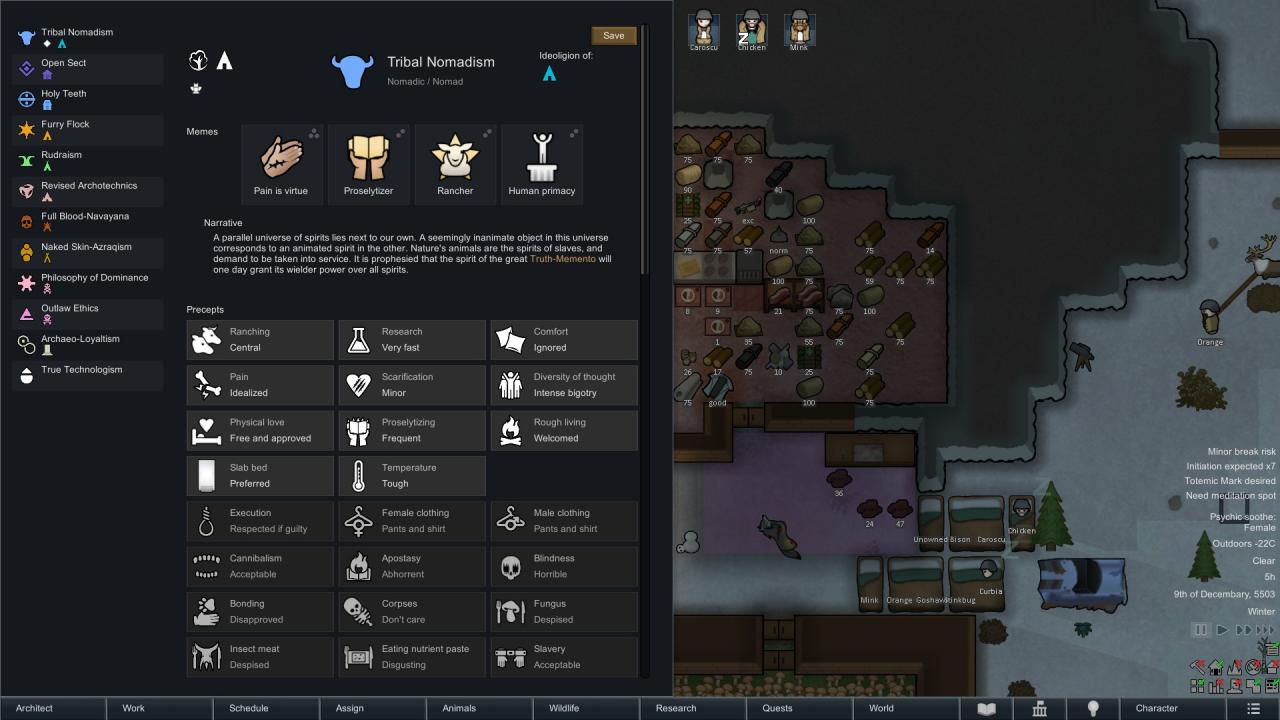This guide discusses various aspects of Nomadic way of life in Rimworld.
Introduction
Nomadic way of life provides for a very different Rimworld play style, and after having done a few runs as a Nomad I decided to share my experiences. Nomadic ranching can be very rewarding when done right, leading to the development of a unique and fun story.
NOTE: This guide is not based on any modding, its principles apply to the base game and the official DLC (Ideology and Royalty).
Why be a Nomad?
Being tied to the land of course has some big advantages, such as the ability to fully exploit the land, amass tremendous wealth, build beautiful cities, etc. It also has the drawbacks of having to defend that land versus all kinds of calamities, since there is no Plan B: you have to defend your home.
Nomadic lifestyle alleviates that issue and in some cases is actually even more efficient than settling.
So, why be a Nomad?
1. To reach the ship that will take you to the stars. On 100% size worlds this is a huge undertaking.
2. To engage in a global campaign of exterminating your enemies, be it Pirates or Nudists, or whomever else.
3. To become the ultimate mercantile faction, visiting every friendly settlement to conduct trade, buying their technological artifacts in exchange fr your endless supply of wool, leather and animals.
Those three would be the primary in-game reasons to pack up and start a new chapter in the life of the New Tribe (or New Arrivals).
Pros and Cons of being a Nomad
Advantages:
1. Versatility.
Settling a tile with the foreknowledge that you will only be there for a short time is very liberating. The tile is not your home, your home happens to be wherever your Horde is. So, if a disaster strikes, you just pack up and leave, taking everything of value along with you.
Volcanic winter has messed up the hunting? — Pack up and leave.
Mechanoid cluster has too much for you deal with? — Pack up and leave.
Toxic Fallout is poisoning the land? — Pack up and leave in a hurry.
Nearby friendly settlements have run out of cash to buy your stuff? — You get the picture.
On top of that, you can survive just about anywhere, eat pretty much anything, and make money even without having a permanent base of operations.
This freedom to move whenever you like, in any direction, flips the game on its head in the sense that the Caravan becomes the normal state of the Horde, while settling is something temporary and done for a very specific purpose.
2. Comparatively low colony wealth.
Nomadic life is minimalist. Minimal buildings, minimal power consumption, minimal production. The lion’s share of the colony wealth falls on people, weapons, consumable artifacts, and war beasts. In other words, most of the colony wealth can fight, allowing the Horde to punch way above the weight of the traditional colony of similar wealth.
3. Ability to bring the weight of the entire colony against its enemies.
No outpost, no settlement, nothing can withstand the onslaught of the Horde with all its people and animals. Not the pirates, not even the Empire, should you choose to fight them. Upon reaching a respectable size the Horde is unstoppable.
Disadvantages:
1. Minimal farming.
Let’s face is, farming is probably the most efficient way to feed the people as well as make money.
It also has the drawback of tying you to the land like nothing else. Thus, Nomads would do little farming. Settling for a season to grow a bunch of Haygrass and maybe a small patch of Cotton?
Sure. Growing Devilstrand or drugs? No. Simpler to buy the drugs and replace devilstrand with high grade leather.
2. Slower than usual Tech Advancement.
Minimalist doesn’t at all mean Low Tech, but since Research can not be done while on the road, the tech will come at a slower rate than it otherwise would. This makes prioritizing crucial techs over less crucial ones that much more important.
The Nomadic Horde
The Horde can be subdivided into three distinct aspects: the People, the Herd, and the Pack.
Below, I will explore and explain these aspects in depth.
The People
1. Reliable
Any trait that causes the pawn to lose self-control (like Gourmand, or Pyromaniac) is dangerous, because a single pawn going on a Mental break while the caravan is packing up will sabotage the entire process thus endangering the Horde.
2. Agreeable
Not everyone is a nice and happy person, and having a single mood decreasing trait like Depressive is not by itself disqualifying. But more than one trait like that? Fuhgettaboutit. Not worth the hassle or the risk.
3. Capable
That Frail seventy-something lovable grandpa with a Bad Back and Dementia would only slow things down. I wouldn’t expel someone who has lived and grown old with the Horde, but recruiting one? Not unless they are absolutely spectacular in some singular task like Cooking or Mining.
The most important thing to remember is that no pawn is too important to sacrifice for the overall good of the Horde.
The Herd
In fact, the number one job of the Herd is to provide the Horde with Packing capacity. Riding is important, Meat is great, Wool and Leather are fine, Milk is okay, but if the animal is unable to carry luggage, it is unfit for the Herd.
Below are some of the animals that I would recommend:
Muffalo
 The old faithful from the days of early access. Good Packing capacity, great Meat yield, okay Leather and Wool quality. Excellent temperature tolerance range from Ice Sheet to Arid Shrubland.
The old faithful from the days of early access. Good Packing capacity, great Meat yield, okay Leather and Wool quality. Excellent temperature tolerance range from Ice Sheet to Arid Shrubland.
Bison
 I still do not understand what is the point of this animal. Just a reskinned Muffalo with slightly worse Wool.
I still do not understand what is the point of this animal. Just a reskinned Muffalo with slightly worse Wool.
Alpaca
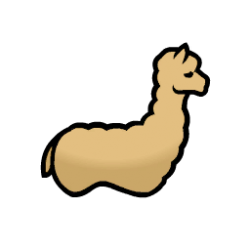 Unassuming and easy to tame. Its excellent Wool and Leather are somewhat overshadowed its its low Meat yield and Packing capacity. It is also more sensitive to cold and does not do well North of Boreal Forest. Nonetheless, an excellent starting animal.
Unassuming and easy to tame. Its excellent Wool and Leather are somewhat overshadowed its its low Meat yield and Packing capacity. It is also more sensitive to cold and does not do well North of Boreal Forest. Nonetheless, an excellent starting animal.
Dromedary
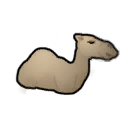 Quite simply the king of Desert biomes. Excellent Camelhide, Packing capacity, and Rideable on top of all of that. Wouldn’t take it North of Boreal Forest, but anywhere warm it rules. Milk instead of Wool is what keeps it from being a perfect Herd animal.
Quite simply the king of Desert biomes. Excellent Camelhide, Packing capacity, and Rideable on top of all of that. Wouldn’t take it North of Boreal Forest, but anywhere warm it rules. Milk instead of Wool is what keeps it from being a perfect Herd animal.
Horse
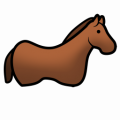 Faster that the Dromedary and with better Cold tolerance. Dromedary of the North, if you will. The single best way to speed up a Caravan.
Faster that the Dromedary and with better Cold tolerance. Dromedary of the North, if you will. The single best way to speed up a Caravan.
Donkey
 A poor man’s Horse. Still, better than nothing.
A poor man’s Horse. Still, better than nothing.
Yak
 No reason to take this one over Muffalo, unless you find Milk useful (I do not).
No reason to take this one over Muffalo, unless you find Milk useful (I do not).
NOTE: I do not rate Milk very highly because it cannot be made into Carnivore Fine Meal. Thus, I prefer Wool when given a choice. Your mileage may vary.
The Pack
Warg
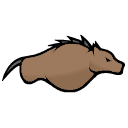
Riddle: What does a Centipede do when surrounded by half a dozen Wargs?
Answer: Waits to die.
The fact that these guys can only eat Meat and corpses is actually a plus. They are guaranteed not to touch any meals meant for the colonists. On top of that, they are not at all voracious, and do not need much food, yet they are vicious enough to hunt wildlife on their own if hungry. They will kill and die for the Horde. Small enough and plentiful enough not to worry too much about friendly fire.
Megasloth
 Just look at this guy. Fully trainable, grazing vegetarian, a veritable monster in combat with excellent Meat, Leather and Wool. One of the few animals able to survive in the Ice Sheet biome.
Just look at this guy. Fully trainable, grazing vegetarian, a veritable monster in combat with excellent Meat, Leather and Wool. One of the few animals able to survive in the Ice Sheet biome.
They are messy, very difficult to tame and have an abysmal birth and maturity rate. Not for the impatient. I treat these like Elite Heavy troopers to be released in an ambush. While tough, they are very susceptible to friendly fire because of their size.
Grizzly Bear
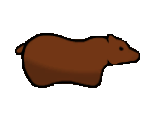 Common, fully trainable, with modest food requirements. At the same time, susceptible to friendly fire, hard to tame and not all that fertile. I generally stick with Wargs.
Common, fully trainable, with modest food requirements. At the same time, susceptible to friendly fire, hard to tame and not all that fertile. I generally stick with Wargs.
Polar Bear
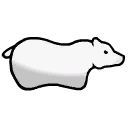 Can cross an Ice Sheet without freezing to death. Otherwise, just a bear.
Can cross an Ice Sheet without freezing to death. Otherwise, just a bear.
Husky
 Few things in Rimworld can match a husky puppy in cuteness. Great haulers and rescuers. Poor fighters. Careful not to get too many of them, because these guys can eat. One Husky eats as much as two Wargs. Can survive the Ice Sheet.
Few things in Rimworld can match a husky puppy in cuteness. Great haulers and rescuers. Poor fighters. Careful not to get too many of them, because these guys can eat. One Husky eats as much as two Wargs. Can survive the Ice Sheet.
Elephant
 Elephants are almost perfect. They are basically fully trainable Herd animals that will provide you with more Meat than you could ever eat, decent Leather, tusks, enormous Packing capacity, while at the same time helping you fight and haul. And Ride.
Elephants are almost perfect. They are basically fully trainable Herd animals that will provide you with more Meat than you could ever eat, decent Leather, tusks, enormous Packing capacity, while at the same time helping you fight and haul. And Ride.
Of course, being as large as they are, they catch every stray bullet, they eat like, well, Elephants, and they crap all over the place.
Totally unsuitable for any biome with a Winter season.
Thrumbo
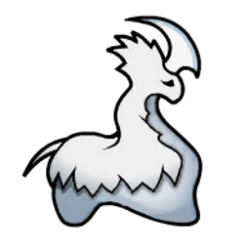 I included these guys because it is difficult to talk about Rimworld fauna without mentioning the Thrumbo. They are not very practical, because getting them is very luck dependent. Getting a breeding pair requires even more luck. They are far more valuable as a source of Thrumbofur
I included these guys because it is difficult to talk about Rimworld fauna without mentioning the Thrumbo. They are not very practical, because getting them is very luck dependent. Getting a breeding pair requires even more luck. They are far more valuable as a source of Thrumbofur
than anything else. Yes, having a Thrumbo is cool, but it is difficult to suggest a strategy around them.
1. Minify all buildings that you plan to take with you (the Stove and various recreation buildings are especially important) AND wait until they have been moved into the Warehouse zone. This due to the fact that stuff left lying outside of a stockpile zone can sometimes be left behind.
2. Make sure that all colonists are happy. If some are unhappy, do not initially add the to the caravan in the caravan menu. Wait until the caravan is almost ready to leave and add them manually at the last moment, or create their own separate mini caravan of unhappy folk. This is important because a single mental break can thwart the entire caravan packing process.
3. Set all pawns to 24 hour work schedule. No sleep, no recreation, just work, work, work until the caravan is packed and ready to leave. Otherwise it will take forever for the caravan to get ready.
The When’s, the Why’s and the How’s of Settling
1. To grow and stock up on plant based resources.
This is especially good in the beginning of the growing season, but does not have to be: Haygrass grows extremely quickly. Cotton takes a tad longer, and Herbal Medicine is best gathered from the wild or bought, since it takes quite a long time to grow.
2. To research a crucial technology.
If you find an important Techprint or two, it might be worthwhile to settle down for a bit and research them.
3. To convert and recruit prisoners.
More often than not, after having raided an enemy settlement you may end up with a few prisoners, some of which might be too valuable to sell. Staying in the enemy settlement invites counter-raids and other headaches, so it is better to settle a fresh tile instead.
4. To conduct long term trade with a number of nearby settlements.
Occasionally you may find a cluster of three or more friendly settlements in relative proximity to one another, that happen to have a lot of useful stuff for sale. This may warrant settling nearby in order to thoroughly exhaust their financial resources while buying off of them anything and everything that presents any value to the Horde.
5. To perform rituals such as Festivals, Sacrifces, etc.
Rituals, if successful, can give some decent rewards, such as new pawns, extra animals, etc. Since they are on a timer, it is prudent to perform them all in bulk, then walk away and let the timers expire while you travel. Cycle, rinse, repeat.
6. To heal the cripples.
I usually wait until about 10% of my pawns are seriously crippled (brain scars, missing eyes, etc.), at which point I would settle, build a number of Biosculpter pods (one per affected pawn), toss them all into the pods and wait for 30 days or so, before they come out all healed up.
Usually of course, the aforementioned reasons come in bulk, so settling kills all those birds with one stone.
As for How to settle, first I would like to show how NOT to settle. Arriving to the destination tile and pressing the Settle button leads to this:
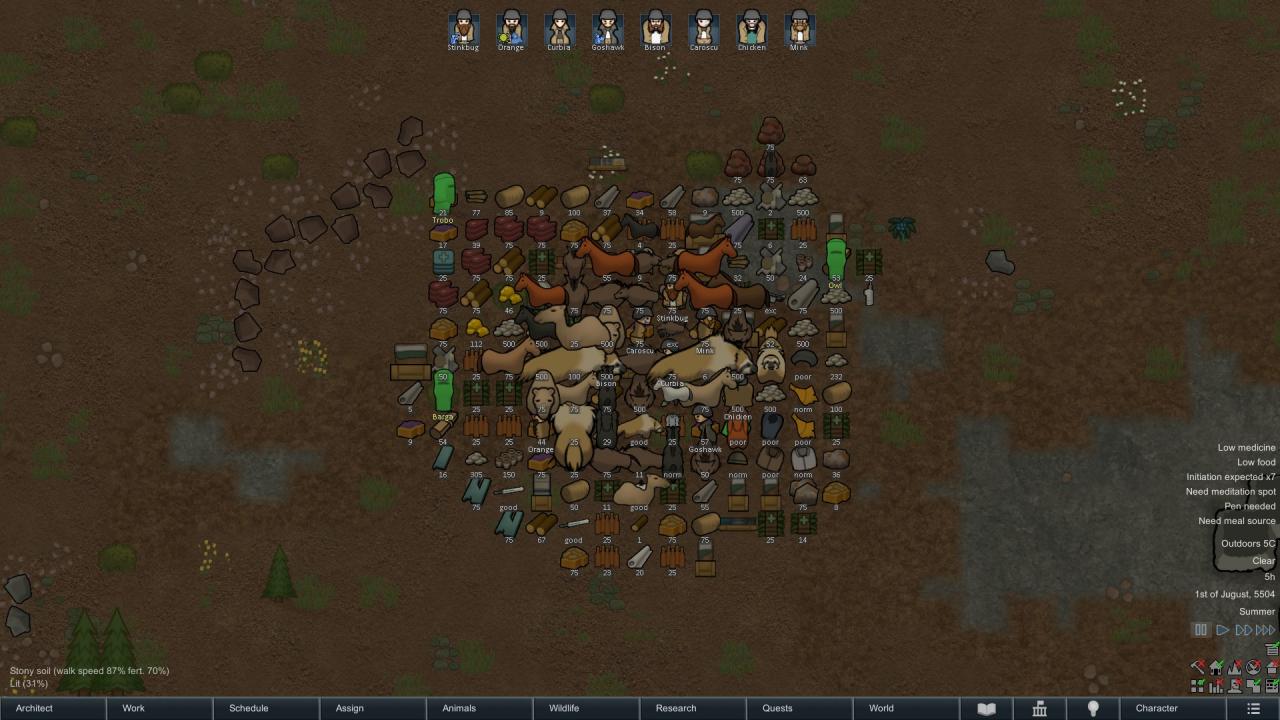
Needless to say, this is a bad idea. Your stuff will rot, your Herd will wander off the map, and you will have a bad time.
How to do it then? There is one extra step that needs to be taken upon arrival to the destination tile on the world map:
The caravan needs to be split in two parts, with one part usually ending up immobile.
The immobile part will consist of the majority of the pawns (especially the builders and the haulers), hauling animals (if any), a couple of days’ worth of food, all the Wood and metals along with all the minified buildings brought over from the previous settlement. Its task is to immediately settle and build two most important structures: the Warehouse and the Pen.
The other (mobile) part of the caravan will consist of the entire herd, a few caretaker pawns and all the perishable materials and items. The Mobile part will remain in caravan form until the Warehouse and the Pen have been built. At that point they can rejoin the newly established settlement in an orderly fashion, i.e. dragging all the animals into the Pen and unloading their cargo into the Warehouse.
NOTE: Since the game does not permit splitting off an immobile caravan, you will be splitting off the mobile one, leaving all the aforementioned building materials with the immobile part.
Notes on Settlement Design
1. The Warehouse
Holds all the precious stuff. Usually also contains the cooking area, the production area, and recreation area. The only structure that needs power. Speaking of power, it is needed to run a Machining Table, a High Tech Workbench, and a cheap CRT TV. That’s it. Anything that can be powered using wood (like Stove or Smithy) should stay that way. As for refrigeration, Nomads do not need refrigeration. Their food stays alive until it is ready to be eaten. Straw matting floor is highly recommended for the warehouse, as it eliminates any chance of food poisonings and allows for safe utilization of otherwise messy hauling animals.
2. The Pen
Holds the Herd. Not much else to say here, except that building solid walls is far preferable to a fence. Contains animal sleeping spots and a shelf or two with Hay/Kibble/Whatever else.
3. The Wall
A walled off area safe from scavengers and manhunter packs.
It is a logical spot for the butchery zone, as well as the sleeping areas for humans, along with outdoor recreation buildings like Telescope and Horseshoe pin.
3. The Prison
As the need arises.
4. The Greenhouse
Once again, situational, but sometimes necessary to save the Herd in the cold season. As the picture shows, it is nothing more than a dark double walled roofed structure built over a geothermal vent. The passive cooler is there to normalize the temperature, so that it never gets too hot. Completely redundant during the growing season.
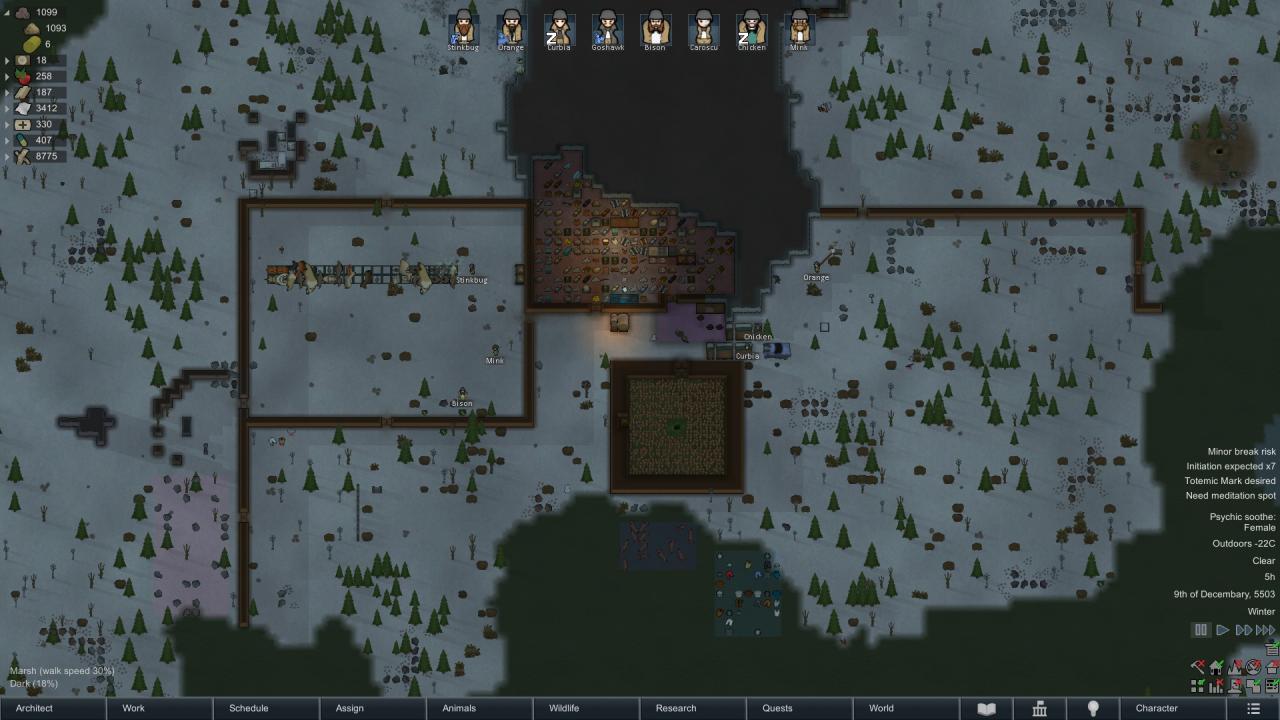
As far as Ideoligions go, they can make the overall experience very pleasant or very painful. Below are my personal recommendations for what to take and what not to take.
Memes
Human Primacy — not just for the almighty Production Specialist, but even more importantly to disable Animal Bonding. Your animals will die in droves, both to feed you and to protect you. Having the Tamer go mental because three of his favorite Wargs just died protecting the colony is something best avoided.
Pain is Virtue — still reigns supreme as the best meme ever. Rough Living, Temperature Tough, Corpses: Don’t Care, there are just too many good precepts that go with this meme.
Ranchers — situational. Animal Specialists are awesome but only if building a Pack of hard to tame and hard to train animals like Megasloths. A non-specialist can safely tame any animal with an Inspiration, but there is a world of difference between a Tame animal and a Trained animal. Ranchers are the best animal trainers.
Supremacist — once again situational. Useful for those who wish to forego building the Pack. Provides Shooting Specialist, which is very nice.
Precepts
Slavery: Acceptable — Nomadic play style does not chime with slavery, but being able to sell prisoners guilt free is a nice perk.
Cannibalism: Acceptable — I find this extremely helpful. Being able to raid a base and having a guaranteed supply of meat for both Humans and Wargs is very handy. Not to mention that Human Leather, while a very poor crafting material, sells for exorbitant amounts of money. As far as the moral aspect goes, it is better to be morally deficient but alive rather than morally superior and dead.
Memes
Animal Personhood — Inferior to Ranchers in every way. Animal Bonding is a liability as is a guilt trip during every meal.
High Life — the antithesis of Nomadic life. Great for those who stick around and work their tile, not so great for Nomads.
Gauranlen Connection — Wood is fuel. Wood is a building material. Wood is not holy. Speaking of Gauranlen trees, they are marginally useful. A single connected Gauranlen tree with a single Medical Dryad will produce a whole lot of herbal medicine for very little effort. Don’t need a meme for that though, just a seed.
Nature Primacy — conflicts with Human Primacy.
Transhumanist — another meme antithetical to Nomadic lifestyle. Normally one of the best memes, but its power and comfort demands are simply too high for a Nomadic Horde.
Tunneler — Nomads travel a lot. Efficient travel means using roads. Rods that almost always go through plains. There is little reason to pick this meme, since mountains and Nomads do not mix.
Sample Ideoligion Setup:
